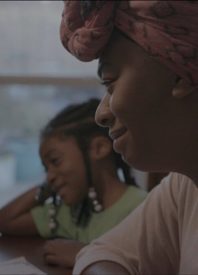
We at In The Seats are usually punctual, but this year’s Shorts Not Pants started on November 19th. And our first review of the shorts blocks are going to start rolling out two days later. A major change this year is that instead of themes, the festival organizes its film in colours. This mixed bag of shorts tackle distances.
Anyway, that first short comes from Or Sinai’s Long Distance, capturing two days in the life of a woman, Rachel (Liora Rivlin) who has to wait for several calls updating her about her daughter giving girth. Rachel’s in Israel, the daughter is in New York, thus the calls, although that seems moot in the world we currently live in. There’s a line here that almost soured me on the film, but two dance sequences pulled me back in.
The next short film is Zoe Zou’s The Bright Fire, about two cousins, Wei (Yunjia Xing) and Liang, who are in different socioeconomic backgrounds. Wei’s birthday approaches and her mother decides that she can only have one gift even if she wants two. The conflict of getting what Wei wants is going to set a chain of events. These events will force her and Liang to figure out how actions have consequences. This makes for depressing but necessary viewing. The block’s best.
Then there’s Tomasz Wolski’s Problem, about a few members of a Polish community (including Dorota Kuduk) coming together to help a dead man only for them to quickly return to fighting about their own, well, problems. My only note about this is that how bad is Poland’s infrastructure that it takes them a while to bring a doctor in to pronounce someone dead. But I feel like that’s a critique of Polish infrastructure. It puts the film and its viewers in the same page.
Men will be men and girls will be girls but both behave in unexpected ways. That seems like a general adage but it applies in Anna Duckworth’s Pain, about a man experiencing a sports related injury and his daughter, Sarah (Eva Gardner) who has to go to the bathroom. She ends up going to the bathroom and after that, at what viewers can assume is a men’s locker room. It’s strange to positively critique a film on what it doesn’t do. But it comments on gender and space without neutralizing those ideas.
Company is difficult to find these days and the next short film captures the current moment. That film is Kiyoko McCrae’s We Stay in the House, chronicling the struggles of biracial and Black mothers from the New Orleans area during the first year of COVID. The camera work here is commendable for a short that has to cover multiple subjects. One mother in particular discusses her difficulties in looking for a job last year. Anecdotes like that add both colour and universality to a subject familiar to most viewers.
Graphic design and its fans take centre frame in Excluded By Design, which specifically looks at how calls for submissions and notices for meetings are technically open to the public except that the design in those notices are too confusing for its target audience. Short films have understandable budgetary constraints. But this film can at least widen its scope a little. For instance, it can explain exactly who these notices are including and excluding. The film also doesn’t clearly differentiate what bad design is versus its good counterparts.
A short film that blurs the line between good and evil between people is Don’t Be Such A Wuss. Here, a teen French bully has his motorcycle breaks down. That breakdown happens in front of the rural house of one of the kids he bullies. And he happens to argue his way into that kid’s house to use his phone. The dynamic here clearly takes inspiration from early Haneke and it’s a concept that can go anywhere. Unfortunately, the tension between these two characters make no sense. And it doesn’t decide on what ending these two characters deserve to have.
Lastly, short films, like their longer counterparts, can make decisive commentaries on society even if they’re using fewer characters or subjects. One such film is Homebird, using animation to tell the story of a woman, NIna (Laura Greenwood’s voice) coming from a rural area to the big city to work on her art in advertising. I’m not necessarily on board with its perception of the rural versus the urban. But its use of colour is great and it deals with its story with enough levity to make it relatable to viewers with their own struggles. Good way to end the block.
Order tickets to Shorts Block: Violet here.
- Release Date: 11/20/2021


